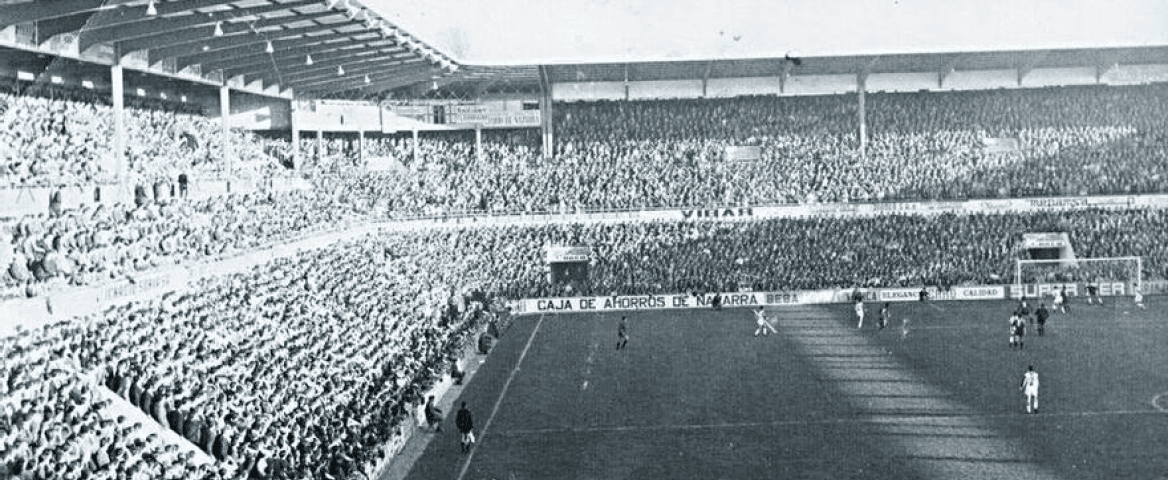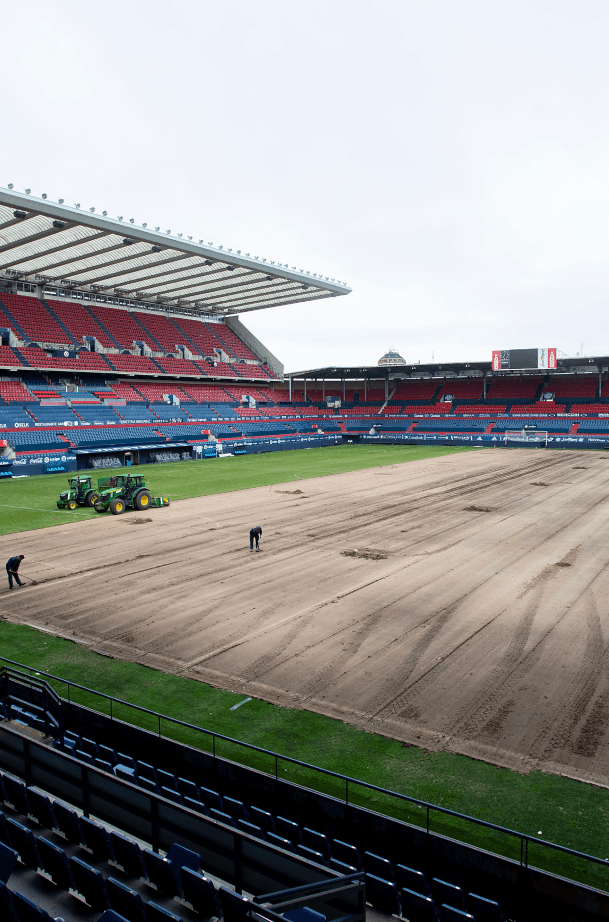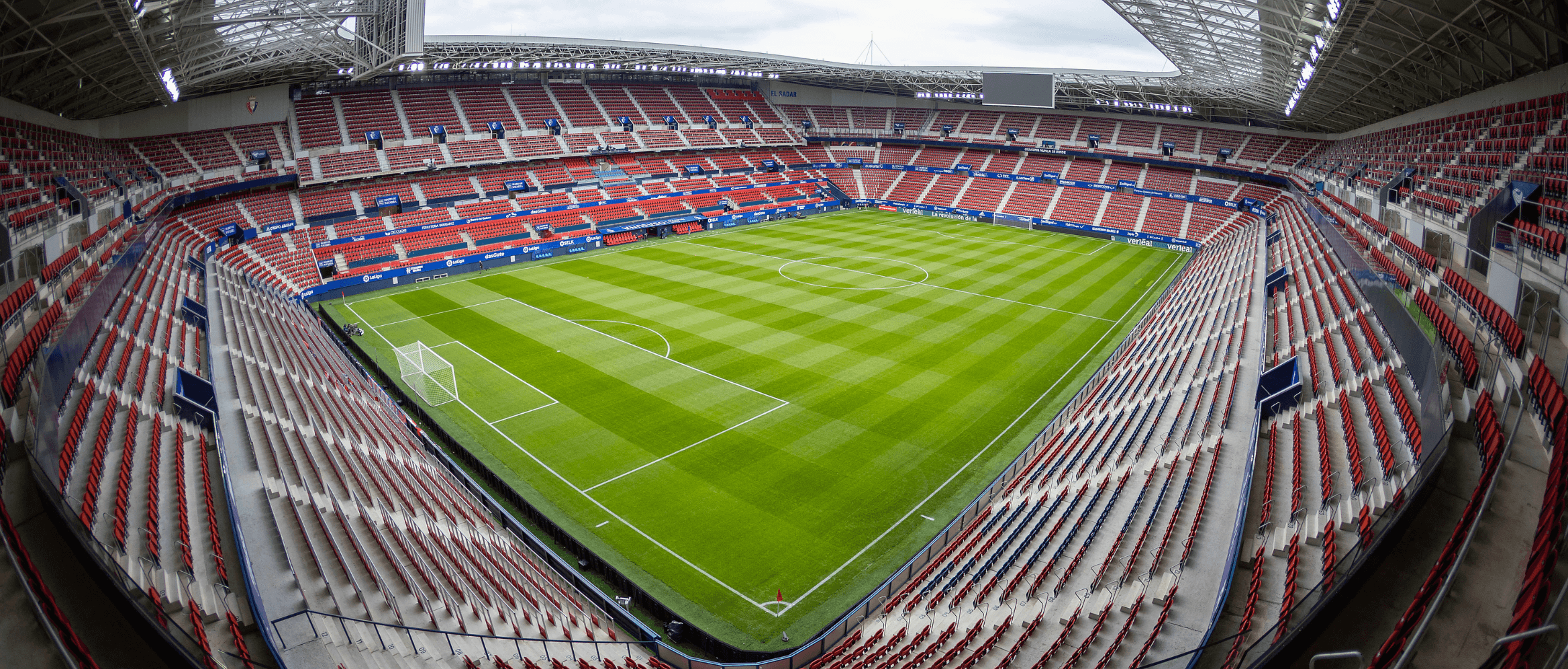C.A. Osasuna played its last game at Campo de San Juan on May 7, 1967, thus saying goodbye to its home since May 21, 1921. The move came after the Delegates' Meeting on April 9, 1965, where they voted to sell the old field, and in April 1966, Sociedad Navarra S.A. paid the club 40 million pesetas for the land. The delegates were clear that the club needed a better field for the fans, with a bigger capacity and artificial lighting to allow for evening matches. Plus, the revenue could help the club reduce the debt they had acquired.
Osasuna purchased the land where the stadium sits for 10 million pesetas (60,000 euros). The building project cost 51 million pesetas, paid for with the money left over from the San Juan sale and savings. Construcciones Carlos Erroz S.A. completed El Sadar in 11 months using 14,000 square meters of cement, 500,000 kilos of steel, and 350,000 for the roof side. The team's new home had a capacity for 25,000 fans, of which 7,000 had a seat.
El Sadar opened on September 2, 1967, with a three-team tournament between Osasuna, Real Zaragoza, and Portuguese side Vitoria de Setúbal. Before the first matchup, all three teams paraded onto the field before a dance group from Pamplona performed for the fans. La Pamplonesa did some music for the event. Plus, all of the Osasuna academy teams marched on the field. The San Fermín chapel priest, the Board of Directors, City Hall members, and other personalities blessed the stadium as it was customed. Following the blessing, club president Jacinto Saldise and stadium architect Tomás Arrarás did the honorary kickoff. At 8 p.m., the game between Real Zaragoza and Vitoria de Setúbal kicked off – the 36 floodlights placed in the corners of the stadium and the 19 ones along each of the sidelines helped were lid up for the first time.
The Three-Team Tournament
C.A. Osasuna, Real Zaragoza, and the Portuguese side Vitoria de Setúbal played in a three-team tournament to inaugurate the stadium. The first game occurred on the same day as the inauguration, with the team from Aragón facing the Portuguese side. In the 57th minute, Vitoria de Setúbal took the lead with a goal by Pedras, making this the first goal at El Sadar. Zaragoza tied the match minutes later, and the game ended 1-1.
Osasuna took the stage the following day and defeated the Portuguese team 3-1. Osaba scored the first rojillo goal at the new stadium. The tournament ended on September 4 with Real Zaragoza defeating C.A. Osasuna 3-0. That evening, the Pamplona Club de Tenis hosted a dinner for the participants and the competent authorities, among others, to conclude the celebrations.
The first official match C.A. Osasuna played at their new home was on September 17, 1967, at 5 p.m. against Sporting Gijón. The Segunda División match ended with a 1-1 draw, with Jordana scoring for los rojillos in front of 16,000 fans.
The first reformation the stadium went under was in the 1977-78 season when the Spanish F.A. requested all Primera & Segunda División teams to add protective fences to increase the security in the stadiums. In the 1981-82 season, C.A. Osasuna defeated F.C. Barcelona 3-2 in the first game ever televised at El Sadar.

The Expansion
In 1989, the club added the Upper Preference Stand to El Sadar for 561 million pesetas. C.A. Osasuna, with no debts at that time, had been left out of the reorganization plan to be carried out by the Administration and was not expected to receive any amount from the income of the pools, as did the clubs that were experiencing economic problems. The president's response at that time, Mr. Fermín Ezcurra, was to build a new stand charged to the private debt that the Liga de Fútbol Profesional would assume. With this modification, the stadium now had a capacity for 30,000 spectators, a figure reduced years later to 20,000 by UEFA's request when, for safety reasons, all stadiums were obliged to have only seated seats.
In December 1998, C.A. Osasuna installed its first official store on the stadium's street level. On May 29, 1999, the C.A. Osasuna offices opened at the back of the stadium. Until that date, the administrative work of los rojillos was managed from the emblematic offices in the Plaza del Castillo, today converted into the headquarters of the club's former players association.
In January 1999, a new modification became a reality: a modern video scoreboard was installed in the corner of the goal stand and the grandstand. On November 13, 1999, the new C.A. Osasuna headquarters and boardroom were inaugurated at the El Sadar stadium. These premises and the offices had been located until that date in the Plaza del Castillo.
Another change during the 1999-00 season was the stadium's facade. That season, two restaurants opened their doors outside the building. The stadium's press room also changed its location.
During the 2002-03 season, the Administration approved several changes to the stadium. The old press boxes were relocated to the upper stand of the stadium. The former reporters' area was used to design VIP seating. The dressing room tunnel was also adapted to the times.
The administrative work of C.A. Osasuna increased, and therefore, the offices were enlarged with the construction of three new offices and a meeting room. On May 14, 2003, premises were also inaugurated so the Federación de Peñas Osasunistas could work independently and comfortably.
The culmination of a modern stadium came in the summer of 2003. The stadium stands were modified in their entirety. With this significant work, the lower part of the stadium was raised almost two meters above the pitch, providing new seats for spectators to be more comfortable and enjoy better visibility. The reform also enlarged width of the sidelines and the bylines and new benches replaced the old ones. The fences separating the stadium from the stands were also removed. Two new video scoreboards at both ends of the stadium completed the new internal image of the stadium. That same summer, the new headquarters of Fundación Osasuna, now located at the back of the El Sadar stadium, was also inaugurated. In 2017, the two video scoreboards, with a surface area of 30 square meters, were replaced by two more modern ones of 45 square meters.

A major change
In 2017 the stadium celebrated its 50th anniversary, and soon after, the biggest remodelation in stadium history was considered. In 2018, club president Luis Sabalza invited architectural firms to submit their bids to reform the rojillo fortress. The aging stadium and a recent club crisis prevented the entity from continuing to upkeep the facility. As the stadium continued to adapt to the different safety norms, it reduced its capacity to 18,500, thus preventing Osasuna from signing new members. Plus, El Sadar needed to meet safety and television needs. Therefore, the Board of Directors considered it necessary to remodel the stadium and increase the capacity to around 25,000 seats.
The club published a set of rules and designed a unique process in football. Architectural firms were free to submit their ideas for the stadium renovation, limited to a maximum cost of 16 million euros plus VAT. In the end, five projects were submitted in which architectural firms and construction companies went hand in hand. Five were presented in October 2018 at the Museum of the University of Navarra in an event attended by the Board of Directors, the staff, club employees, veterans, and partners. After a period in which members got more details on each of the projects, all club members over 18 were called to the polls. Just over 11,000 members had the right to participate in the vote, reaching the highest mobilization percentage in the club's history with a 75% turnout and more than 8,400 votes. Members could vote in person and online for the first time in the club's history.
Club members could choose between an essential refurbishment at a lower cost and without expansion, an option 7.6% of the members chose, or a more ambitious reform with a capacity expansion, the winning option with 90.3% of the votes. Among the five projects presented, Muro Rojo, by OFS Architects and the VDR construction company, won 45.3% of the votes.
In June 2019, work began in the Preference sector. All the rooms on the first floor were demolished to create new, larger locker rooms for the teams and referees and a new anti-doping room. The home team's locker room added a second floor prepared for activation exercises. The tunnel area between the two locker rooms was enlarged, and the exit area to the field of play and the mixed zone were completely refurbished. New offices were built for the Commercial and Communication Departments on the second floor.
The reform included a press room, VIP suites, and media booths. Desks were also built in the Upper Grandstand to accommodate all the accredited media during the matches of maximum expectation. The two existing elevators were renovated, the party suites were rebuilt entirely, bringing their location closer to the field, and the restrooms for the public were improved. The most critical work included providing the Upper Grandstand with an independent stairway access and widening the vomitories. The seats in the entire Preferencia area were completely renovated.
At the end of October 2019, the second phase of the refurbishment began with the foundation work for the new upper ring of bleachers, which expanded the stadium's capacity to 23,500 spectators. Spectator access to the stadium was modified, allowing the street level to be freed up for commercial premises. A new office was installed on Sadar Street, and the store was completely refurbished. In addition, the two restaurants already operating in El Sadar doubled their space, and the club reserved several spaces for commercial premises.
The seating throughout the stadium was renovated, and the VIP areas were significantly expanded with the construction of new party suites in Lateral and the creation of the Premium Zone, with capacity for more than 200 people, and the Sala 1920, an air-conditioned space of more than 400 square meters with capacity for almost 200 spectators with seats in the stadium.
The work improved access to the stadium, toilets, catering, and, in general, all the services available. Four new elevators were installed in each of the corners of the building to allow mobility for spectators with difficulties, and more than 70 handicapped seats were created.
The stadium lighting was renovated entirely and replaced with LEDs, as was the public address system throughout the stadium. The roof of the entire stadium was also replaced with a new one. All these changes helped El Sadar earn the 2021 best stadium in the world among those newly built or renovated award by 'Stadium Database.'
On June 5, 2022, El Sadar hosted an international friendly match between the Argentina national team and the Estonian national team, which ended with a 5-0 result in favor of the Argentines. Leo Messi was the hero of the night, scoring all five of his team's goals, the first time he had achieved such a feat with the Albiceleste. 18,332 fans attended the match.



















